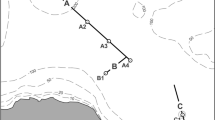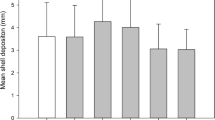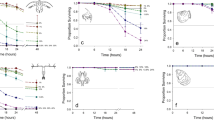Abstract
Four 28-day seasonal experiments were conducted using selected estuarine animals in outdoor tanks that received continuous flow of mirex-laden water. Mirex (dodecachlorooctahydro-1,3,4-metheno-2H-cyclobuta [cd] pentalene) leached from fire ant bait (0.3% mirex) by fresh water and then mixed with salt water was toxic to blue crabs (Callinectes sapidus), pink shrimp (Penaeus duorarum), and grass shrimp (Palaemonetes pugio) but not to sheepshead minnows (Cyprinodon variegatus), at concentrations less than 0.53μg/L in water. The amount of leaching was greatest in summer and least in spring. Greatest mortality occurred in summer at the highest water temperature and concentration of mirex; least mortality occurred in spring at next to the lowest temperature and at the lowest concentration. Earliest deaths of blue crabs occurred after six days of exposure and shrimps after two days. Small juvenile crabs were more sensitive to leached mirex than were large juveniles. Mirex did not appear to affect growth or frequency of molting in crabs. All exposed animals concentrated mirex. Among animals that survived for 28 days, sheepshead minnows concentrated mirex 40,800X above the concentration in the water, blue crabs 2,300X, pink shrimp 10,000X, and grass shrimp 10,800X. Sand substrata contained mirex up to 770X that in the water. Most control and exposed animals in samples examined histologically had normal tissues, but alteration in gills of some exposed fish and natural pathogens in some exposed and control crabs and shrimp were observed. The experiments demonstrated that mirex can be leached from bait by fresh water, concentrated by estuarine organisms, and can be toxic to crabs and shrimps.
Similar content being viewed by others
References
Bookhout, C. G., A. J. Wilson, Jr., T. W. Duke, and J. I. Lowe: Effects of mirex on the larval development of two crabs. Water, Air, Soil Pollut.1, 165 (1972)
Borthwick, P. W., T. W. Duke, A. J. Wilson, Jr., J. I. Lowe, J. M. Patrick, Jr., and J. C. Oberheu: Accumulation and movement of mirex in selected estuaries of South Carolina, 1969–71. Pestic. Monit. J.7, 6 (1973).
Butler, P. A.: Commercial Fisheries Investigations. In, Pesticide-Wildlife Studies: A Review of Fish and Wildlife Service Investigations during 1961 and 1962. U. S. Fish Wildl. Serv. Circ.167, 11 (1963).
Collins, H. L., J. R. Davis, and G. P. Markin: Residues of mirex in channel catfish and other aquatic organisms. Bull. Environ. Contam. Toxicol.10, 73 (1973).
Cooley, N. R., J. M. Keltner, Jr., and J. Forester: Mirex and Aroclor® 1254: Effect on and accumulation byTetrahymena pyriformis Strain W. J. Protozool.19, 636 (1972).
Couch, J. A.: Free and occluded virus, similar toBaculovirus, in hepatopancreas of pink shrimp. Nature247, 229 (1974).
Hansen, D. J., P. R. Parrish, and J. Forester: Aroclor® 1016: Toxicity to and uptake by estuarine animals. Environ. Res. (In press).
Lowe, J. I., P. R. Parish, A. J. Wilson, Jr., P. D. Wilson, and T. W. Duke: Effects of mirex on selected estuarine organisms. Trans. 36th N. Am. Wildl. Nat. Resour. Conf., p. 171 (1971).
Lowe, J. I., P. D. Wilson, and R. B. Davison: Effects of mirex on crabs, shrimp, and fish. In, Progress Report of the Bureau of Commerical Fisheries, Center for Estuarine and Menhaden Research, Pesticide Field Station, Gulf Breeze, Fla., 1969. U. S. Fish Wildl. Serv. Circ.335, 22 (1970).
Ludke, J. L., M. T. Finley, and C. Lusk: Toxicity of mirex to crayfish,Procambarus blandingi. Bull. Environ. Contam. Toxicol.6, 89 (1971).
McKenzie, M. D.: Fluctuations in abundance of blue crab and factors affecting mortalities. S. C. Wildl. Resour. Dept., Mar. Resour. Div., Tech. Rep. No. 1, 45p (1970).
Muncy, R. J., and A. D. Oliver, Jr.: Toxicity often insecticides to the red-crawfish,Procambarus clarki (Girard). Trans. Am. Fish. Soc.92, 428 (1963).
Redmann, G.: Studies on the toxicity of mirex to the estuarine grass shrimp,Palaemonetes pugio. Gulf Res. Rep.4, 272 (1973).
Tagatz, M. E.: Growth of juvenile blue crabs,Callinectes sapidus Rathbun, in the St. Johns River,Florida. U. S. Fish Wildl. Serv. Fish. Bull.67, 281 (1968).
Van Valin, C. C., A. K. Andrews, and L. L. Eller: Some effects of mirex on two warm-water fishes. Trans. Am. Fish. Soc.97, 185 (1968).
Author information
Authors and Affiliations
Rights and permissions
About this article
Cite this article
Tagatz, M.E., Borthwick, P.W. & Forester, J. Seasonal effects of leached mirex on selected estuarine animals. Arch. Environ. Contam. Toxicol. 3, 371–383 (1975). https://doi.org/10.1007/BF02220749
Received:
Accepted:
Issue Date:
DOI: https://doi.org/10.1007/BF02220749




